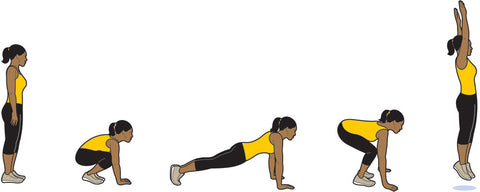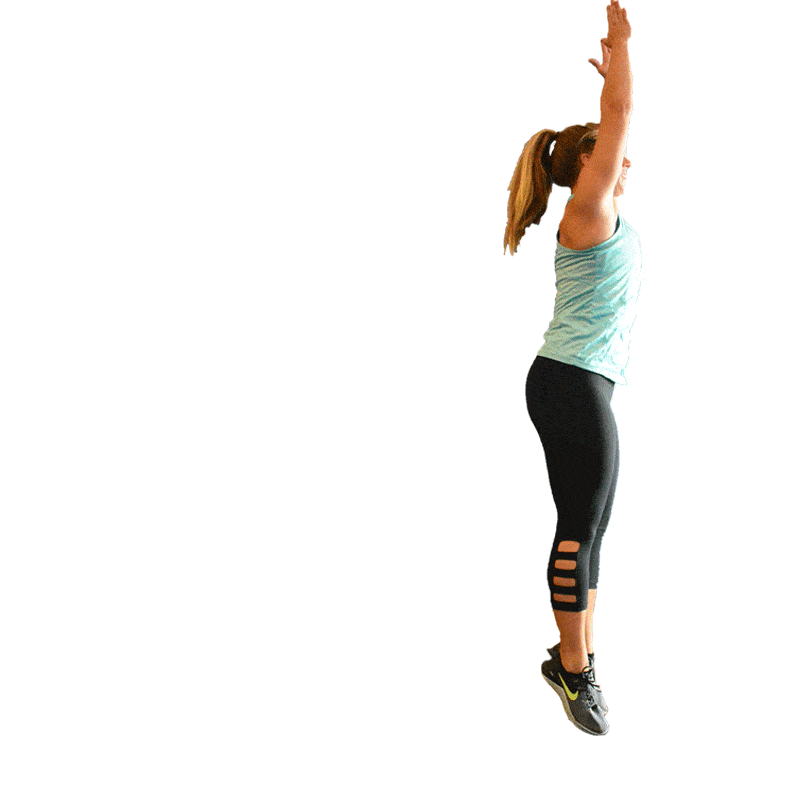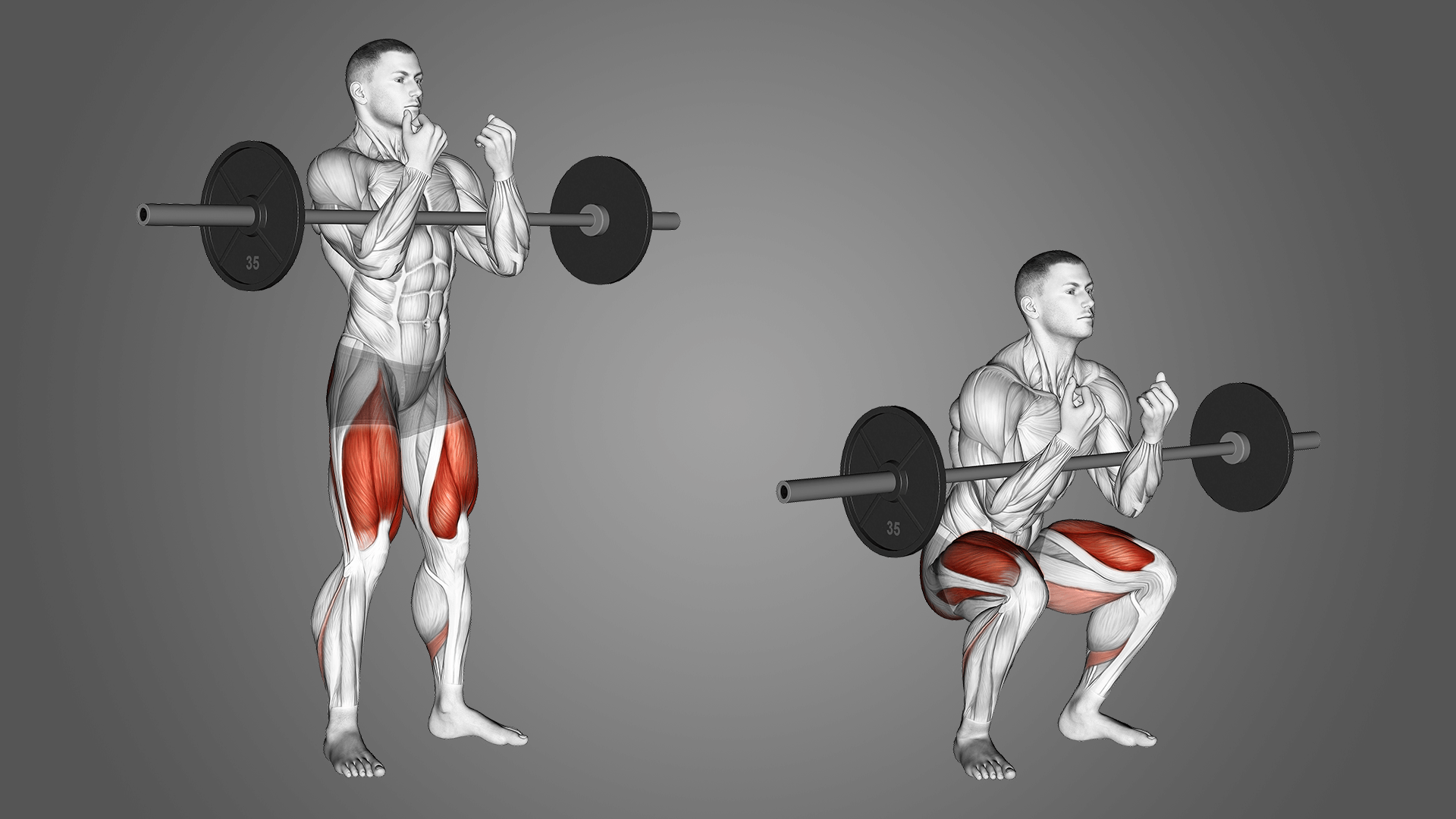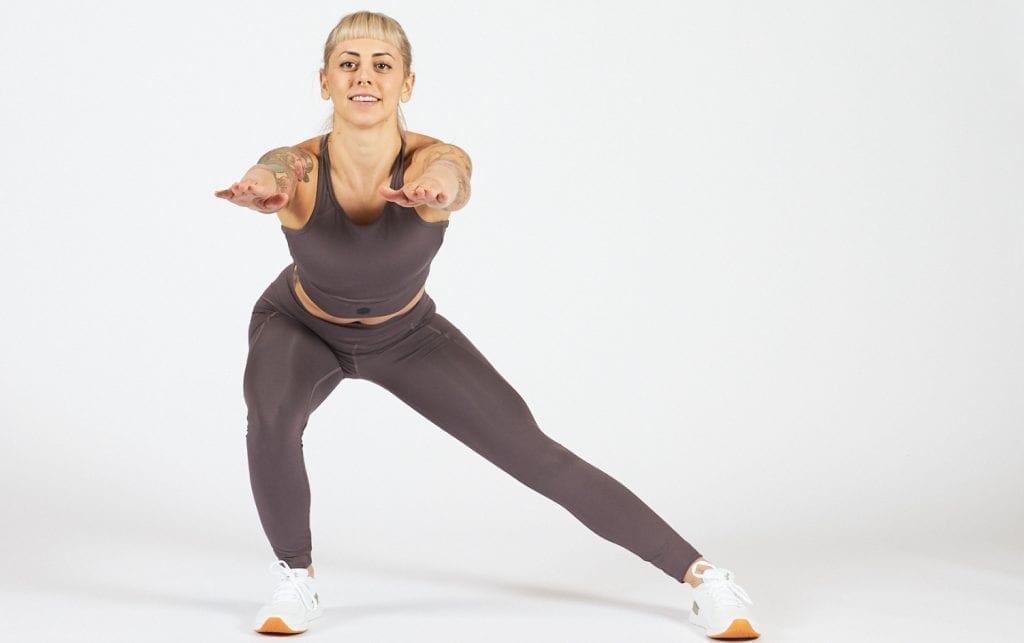
Burpees are hailed as one of the most effective full-body exercises, combining strength, cardio, and endurance in one dynamic movement. While they may seem daunting at first, mastering burpees can significantly enhance your fitness level and overall athleticism. As a fitness trainer, I've witnessed firsthand the transformative power of this exercise when performed correctly. In this comprehensive guide, I'll break down the burpee into five easy-to-follow steps, providing detailed explanations and tips to help you perfect your form and maximise your results.
Despite their numerous benefits, mastering burpees can be challenging, especially for beginners. However, with dedication and proper guidance, individuals can quickly improve their proficiency and reap the rewards. As a fitness trainer, I've witnessed clients experience remarkable transformations in their strength, endurance, and body composition through consistent burpee training.
In this guide, I aim to demystify the burpee by breaking it down into five digestible steps. By understanding the mechanics of each phase and implementing specific techniques, you can optimise your performance and achieve superior results. Whether you're a novice looking to incorporate burpees into your routine or an experienced athlete seeking to refine your technique, this comprehensive guide will provide invaluable insights to elevate your burpee game.
Burpees are a dynamic full-body exercise that combines elements of strength, cardio, and agility into one fluid movement. They typically involve transitioning from a standing position to a plank, performing a push-up, returning to a squat position, and then explosively jumping into the air with arms raised overhead. This exercise engages multiple muscle groups simultaneously, including the chest, shoulders, arms, core, and legs, making it highly effective for building strength, endurance, and cardiovascular fitness.
What are Burpees and what are its Benefits?
Before we dive into the guide,let's first explore what are burpees and why everyone is talking about it:
Burpees are a dynamic full-body exercise that combines elements of strength, cardio, and agility into one fluid movement. They typically involve transitioning from a standing position to a plank, performing a push-up, returning to a squat position, and then explosively jumping into the air with arms raised overhead. This exercise engages multiple muscle groups simultaneously, including the chest, shoulders, arms, core, and legs, making it highly effective for building strength, endurance, and cardiovascular fitness.
Burpees offer a multitude of benefits for overall fitness and athletic performance. Here are some of the key advantages of incorporating burpees into your workout routine:
Full-Body Workout
Burpees engage multiple muscle groups simultaneously, including the chest, shoulders, arms, core, glutes, and legs. This comprehensive activation of muscles provides a total body workout in a single exercise, making it highly efficient for building strength and muscle tone.Cardiovascular Conditioning
Burpees are a high-intensity exercise that elevates heart rate rapidly, providing a cardiovascular challenge that improves endurance and stamina. Performing burpees regularly can enhance cardiovascular health, increase lung capacity, and improve overall aerobic fitness.Fat Burning
Due to their high-intensity nature, burpees are effective for burning calories and promoting weight loss. Incorporating burpees into a workout routine can help accelerate fat loss by boosting metabolism and increasing energy expenditure both during and after exercise.
Functional Strength
Burpees mimic real-life movements such as squatting, pushing, and jumping, making them a functional exercise that translates to improved strength and agility in everyday activities. By strengthening the muscles used for lifting, pushing, and stabilizing, burpees can enhance functional fitness and reduce the risk of injury.Improved Athletic Performance
Burpees develop speed, power, and agility, which are essential components of athletic performance in sports such as basketball, soccer, and martial arts. By enhancing explosiveness and coordination, burpees can help athletes improve their agility, reaction time, and overall athletic prowess.Minimal Equipment Required
Burpees can be performed virtually anywhere with minimal equipment, making them a convenient and accessible exercise option. Whether you're at home, in the gym, or outdoors, you can incorporate burpees into your workout routine without the need for specialised equipment.
Time Efficiency
Burpees are a time-efficient exercise that delivers maximum results in a short period. Since they target multiple muscle groups and provide a cardiovascular challenge, you can achieve a high-quality workout in a relatively brief amount of time, making burpees ideal for busy individuals with limited time for exercise.Versatility
Burpees can be modified and progressed to suit individuals of all fitness levels, from beginners to advanced athletes. Variations such as modified burpees, plyometric burpees, and burpee variations with added resistance allow for customization based on individual goals and abilities.Overall, the benefits of doing burpees extend far beyond just physical fitness, encompassing improvements in strength, endurance, cardiovascular health, and functional performance. Incorporating burpees into your workout routine can enhance your overall fitness level and contribute to a healthier, more active lifestyle.
So,Now that we know little basics of Burpees ,let’s delve into the proper form to understand them better:
Step 1: Proper Form and Alignment
The foundation of a successful burpee lies in maintaining proper form and alignment throughout the movement. Begin in a standing position with your feet hip-width apart, shoulders relaxed, and core engaged. As you lower into a squat position, ensure that your knees are tracking over your toes and your weight is evenly distributed through your heels. Keep your chest lifted and spine neutral to avoid rounding your back.
As you transition into the plank position, extend your legs behind you, forming a straight line from your head to your heels. Engage your core and glutes to stabilise your body and prevent your hips from sagging or lifting too high. Maintain a slight tuck of the chin to keep your neck in alignment with your spine.
Step 2: Controlled Descent and Explosive Jump
Once in the plank position, lower your chest to the ground with control, keeping your elbows close to your body. Avoid collapsing your chest or allowing your hips to dip towards the floor. As you push through your palms, explode off the ground, driving your feet towards your hands in one fluid motion.
The explosive jump is a key component of the burpee, activating fast-twitch muscle fibers and elevating your heart rate. Focus on generating power from your lower body while maintaining stability through your core and upper body. Land softly with bent knees to absorb the impact and immediately transition into the next repetition.
Step 3: Breathing Technique
Effective breathing is essential for sustaining energy and endurance during high-intensity exercises like burpees. Focus on inhaling deeply through your nose as you lower into the squat position, filling your lungs with oxygen and bracing your core. Exhale forcefully through your mouth as you explode off the ground, releasing tension and powering through the movement.
Maintaining a rhythmic breathing pattern will help regulate your heart rate and prevent fatigue. Remember to breathe consistently throughout each repetition, avoiding shallow or erratic breaths that can compromise your performance. Practice synchronising your breath with the movement to optimise efficiency and maximise your output.
Step 4: Modifications and Progressions
Burpees can be tailored to accommodate individuals of all fitness levels, making them a versatile exercise for beginners and seasoned athletes alike. If you're new to burpees or recovering from an injury, start with modified variations such as step-back burpees or plank-to-squat transitions.
As you build strength and confidence, gradually increase the intensity by incorporating advanced variations such as burpee tuck jumps, push-up burpees, or burpee box jumps. These progressions challenge different muscle groups and elevate the cardiovascular demand, pushing you to new levels of performance.
Consult with a qualified fitness professional to determine the appropriate modifications and progressions based on your fitness goals and abilities. Listen to your body and progress at a pace that feels challenging yet sustainable, avoiding the temptation to sacrifice form for intensity.
Step 5: Incorporating Burpees into Your Workout Routine
To reap the full benefits of burpees, integrate them strategically into your workout routine as part of a comprehensive training program. Consider incorporating burpees as a dynamic warm-up to prime your body for exercise, or incorporate them into circuit-style workouts for a high-intensity cardio and strength challenge.
Experiment with different rep schemes, timing intervals, and variations to keep your workouts engaging and effective. Aim to perform burpees with proper form and intensity, focusing on quality over quantity. Track your progress over time, gradually increasing the volume and intensity as you improve your fitness level.
Safety First: Essential Precautions for Performing Burpees Safely
While burpees offer numerous fitness benefits, it's important to prioritize safety to prevent injury and ensure a positive exercise experience. Here are some safety precautions to keep in mind when performing burpees:
- Warm-Up, Begin your workout with a proper warm-up to prepare your muscles and joints for exercise. Incorporate dynamic movements such as jogging, arm circles, and leg swings to increase blood flow and flexibility.
- Progress Gradually, If you're new to burpees or returning from a break, start with modified variations and gradually progress to more advanced versions as your strength and endurance improve. Avoid overexertion and listen to your body's signals to prevent overtraining and injury.
- Maintain Proper Form, Focus on maintaining proper form throughout each repetition of the burpee. This includes keeping your spine neutral, engaging your core, and aligning your joints correctly. Avoid arching or rounding your back, and be mindful of your knees and wrists during transitions.
- Land Softly, When performing the explosive jump in the burpee, focus on landing softly with bent knees to absorb the impact and reduce stress on your joints. Avoid landing with locked knees or collapsing into the squat position, as this can increase the risk of injury.
- Modify as Needed, Listen to your body and modify the burpee as needed to accommodate any existing injuries or limitations. If you experience pain or discomfort during the exercise, consider adjusting the range of motion, reducing the intensity, or choosing alternative exercises that are more suitable for your needs.
- Stay Hydrated, Drink plenty of water before, during, and after your workout to stay hydrated and support optimal performance. Dehydration can increase the risk of fatigue, cramps, and injury, so make hydration a priority throughout your exercise session.
- Rest and Recovery, Allow adequate time for rest and recovery between workout sessions to prevent overuse injuries and promote muscle repair and growth. Incorporate rest days into your routine, and prioritise quality sleep and nutrition to support overall health and fitness.
- Listen to Your Body, Pay attention to how your body feels during and after exercise, and adjust your intensity or volume accordingly. If you experience persistent pain, discomfort, or fatigue, it's important to take a break and seek medical attention if necessary.
By following these safety precautions and exercising with mindfulness and intention, you can enjoy the benefits of burpees while minimising the risk of injury and promoting long-term health and fitness. Remember to prioritise safety, listen to your body, and seek guidance from a qualified fitness professional if you have any concerns or questions about your exercise routine.
How can you add burpees in your workout routine?
Incorporating burpees into your workout routine can add variety, intensity, and effectiveness to your training regimen. Here are several ways to integrate burpees into your workouts:
Stand-Alone Burpee WorkoutsDedicate a portion of your workout session solely to burpees. Perform sets of burpees with designated rest intervals in between. For example, you could do 3 sets of 10-15 burpees with 60 seconds of rest between sets.
Circuit Training
Include burpees as one of the exercises in a circuit workout. Create a circuit that includes a mix of strength, cardio, and core exercises, and perform each exercise for a set amount of time or repetitions before moving on to the next. For instance, complete a circuit consisting of push-ups, squats, jumping jacks, and burpees, performing each exercise for 30 seconds with 15 seconds of rest in between.
Interval Training
Incorporate burpees into high-intensity interval training (HIIT) workouts. Alternate between periods of maximum effort, during which you perform burpees, and periods of active recovery or rest. For example, do 30 seconds of burpees followed by 30 seconds of jogging or walking, and repeat for several rounds.
Tabata Protocol
Follow the Tabata protocol, which involves performing exercises at maximum intensity for 20 seconds followed by 10 seconds of rest, repeated for 8 rounds (4 minutes total). Include burpees as one of the exercises in a Tabata-style workout, alternating with other exercises such as mountain climbers, jumping lunges, or high knees.
Pyramid Workouts
Incorporate burpees into pyramid-style workouts, where you gradually increase and then decrease the number of repetitions. For example, start with 1 burpee, then perform 2, 3, 4, and so on, until you reach a peak number (e.g., 10), then work your way back down to 1. Rest briefly between sets as needed.
Finishers
Use burpees as a finisher at the end of your regular workout routine to push yourself to the limit and burn extra calories. Perform a set number of burpees (e.g., 50 or 100) as fast as possible, aiming to complete them with good form and intensity.
Incorporate into Sports Training
If you participate in sports or athletic activities, incorporate burpees into your training to improve agility, explosiveness, and conditioning. For example, do a set of burpees followed by sprints, agility drills, or sport-specific movements.
When adding burpees to your workout routine, it's essential to consider your fitness level, goals, and any existing injuries or limitations. Start with a manageable volume and intensity, and gradually increase as you become more proficient and conditioned. Be sure to warm up properly before performing burpees and cool down afterward to promote recovery and reduce the risk of injury.
Conclusion
Mastering the art of burpees in just five steps is an achievable and rewarding journey for overall fitness and athleticism. By following the detailed guidance provided in this guide, you can optimise your technique, minimise injury risk, and maximise results. Burpees offer a comprehensive workout targeting multiple muscle groups, enhancing cardiovascular health, functional strength, and athletic performance.
Consistency, patience, and proper progression are key to success. Whether you're a beginner or seasoned athlete, integrating burpees strategically into your routine offers versatile training options. Embrace the challenge, respect your limits, and prioritise safety. With dedication and perseverance, mastering burpees will unlock your full fitness potential, bringing transformative benefits to your fitness journey.
References
- Al Kavadlo, "Bodyweight Strength Training Anatomy" (2013).
- Mark Lauren, "You Are Your Own Gym: The Bible of Bodyweight Exercises" (2010).
- Bret Contreras, "Bodyweight Strength Training Anatomy" (2013).
- Brad Schoenfeld, "Science and Development of Muscle Hypertrophy" (2016).
- American Council of Exercise, "ACE Fitness Study: Investigating the Efficacy of Bodyweight Training" (2013).










